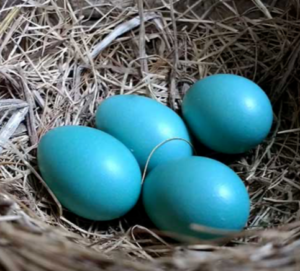Turquoise in the spotlight
North American robin eggs
According to the jeweller David Webb, ‘Turquoise is becoming on everyone. It lights up the face’. At its most pure turquoise is the hue of a vivid summer sky – a universally understood and adored colour. Turquoise is frequently partnered with diamonds and a number of spectacular jewels in this combination were created in the 1950s and 60s – in 1966 Lana Turner wore David Webb’s bold diamond and turquoise suite in her lead role in the film Madame X, and in August 1967 Town & Country’s cover girl, Carmen Mayrink Viega was shot wearing fabulous girandole diamond and turquoise earrings, also by David Webb.
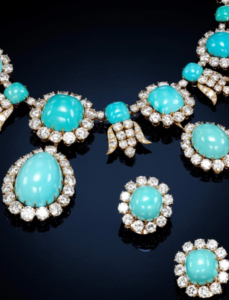
A turquoise and diamond parure, Van Cleef & Arpels, 1960s | Image: Sotheby’s
The best quality turquoise is akin to the colour of the eggs of the American robin, and the light medium tone is Tiffany’s corporate colour, used in signage, packaging and on the covers of its mail order catalogue, the Blue Book.
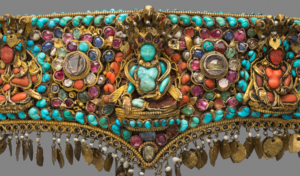
Detail, forehead ornament for a Crown or a Deity, 17th-19th century, Newari for Nepal or Tibet market, gilt silver, brass, diamonds, emeralds, rubies, sapphires, pearls, coral, shell, turquoise, and semi precious stones | Image: Metropolitan Museum of Art, New York
The American designer and outdoor lifestyle guru Ralph Lauren has been synonymous with turquoise for many years. In 2005 Lauren launched the fragrance Pure Turquoise, the copy used in its advertising stated it was to be worn by ‘A woman open to new experiences, who appreciates beauty in all its forms and embraces nature and its mysteries’ and the bottle stopper took the form of an irregular black-veined turquoise. In late 2023 Ralph Lauren introduced a programme of artists in residence – a collaboration with indigenous American communities – the first artist in the scheme, Naiomi Glasses, a designer and weaver, stated that in her view, ‘No outfit is truly complete without turquoise’, she advocates and promotes contemporary, native jewellery made in the US southwest.
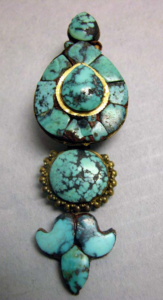
Earring, 17th-19th century, Tibet, Lhasa area, gold with turquoise | Metropolitan Museum of Art, New York
Turquoise is semi-precious, simply because of its value when compared with big gem stars such as diamonds and rubies, but its finer grades are as prized as precious stones. And, as with all gemstones, colour is key: the blue of the turquoise mined near the city of Neyshabur, Iran, is the guide for the evaluation of quality although turquoise is often seen and is immensely popular in shades of green-blue and green. On the Mohs scale of hardness turquoise scores 5-6 and has a waxy lustre, despite its low hardness relative to other gems, it can take a good polish. As to the chemistry: turquoise is hydrated copper aluminium phosphate, formed when water in the form of rain or melting snow percolates through copper porphyry, the dissolved oxygen in the water oxidises copper sulfides to soluble sulfates and the resulting acidic copper-laden solution then reacts with aluminium and potassium found in the host rock to form turquoise, which then fills veins in volcanic rock most often in arid environments.
Turquoise was one of the first gems to be mined, and many historic sites are now depleted although a few are still worked. Mining operations tend to be small in scale and seasonal due to the limited scope and remoteness of deposits, which are often in small volumes, and most working is performed by hand with little or no mechanisation.
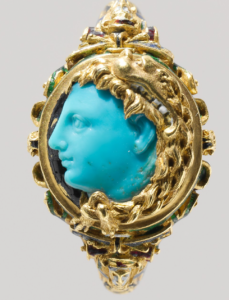
Ring, mid-16th century; cameo, early Hellenistic 4th century BCE, probably Italian, turquoise, enamel and gold, the cameo possibly depicts Alexander the Great. It is rare to find a cameo in turquoise, in any period, and it is likely that the setter believed it to be ancient | Image: Metropolitan Museum of Art, New York
Iran has been an important source of turquoise for at least 2,000 years. It is seen widely in architecture, invariably covering the domes of palaces as its intense blue was seen as the symbol of heaven on earth. Turquoise in Iran has a spiritual dimension and value, with connotations of victory, triumph and prosperity. Poets have celebrated it, and various legends and beliefs are linked to turquoise. The Dehloran Plain, western Iran, has been the subject of much archaeological research and turquoise beads found in discoveries here indicate that the material was possibly first used around 7,000 BCE. The quantity of turquoise found in artefacts suggests it was important in traditions, and although it can be dated the turquoise cannot be traced to a specific location. The deposits at Neyshabur are historically and known widely as ‘Persian turqoise’, but turquoise is found in other locations within Iran, including the Shahr-i Babak deposit in western Kerman Province which is mentioned by Marco Polo, in his Book of the Wonders of the World, 1390-1430. The Neyshabur mine is the only Iranian mine dedicated to turquoise production alone, whereas other deposits are primarily concerned with copper and gold extraction with turquoise retrieved as part of the process. The Neyshabur mine employs around 200 workers, with four tons of rough turquoise removed per month and annual production at approximately 40-42 tons.
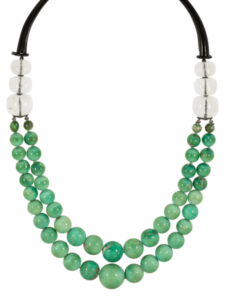
Art Deco rock crystal, black lacquer and turquoise bead necklace, designed by Suzanne Belperron for René Boivin, France, circa 1925 | Image: Stephen Russell
The finest turquoise does not require treatment, but lower grade turquoise can be soft, chalky and pale blue in colour and needs stabilisation to avoid breakages when worked in jewellery. Untreated turquoise might certainly be more natural and it sounds appealing but exposure to chemicals, oils, perfume, sweat, sunlight and heat over time can alter its colour. However, it is worth noting that despite such contact changes in colour might not be visible for many years and sometimes not at all. Stabilisation entails adding a plastic filler under pressure to the holes or pits already present within the structure of turquoise and once balanced it can also be colour enhanced if necessary. It is estimated that approximately 90% of the turquoise offered on the market today has either been stablised or enhanced.
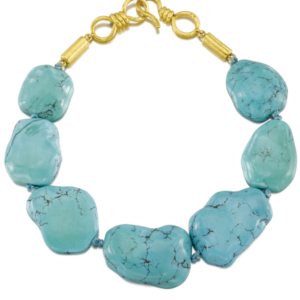
Gold and turquoise necklace, Suzanne Belperron, 1955-1970, the seven blue-green turquoise stones show typical veining and have no indication of treatment | Image: Sotheby’s
Turquoise was also known in ancient Egypt from at least 3000 BCE, and its source is the Sinai Peninsula where there are six mines. One of the most noteworthy is Serabit el-Khadim, located about 4km from an ancient temple dedicated to the deity Hathor, a major figure in ancient Egyptian religion with several roles: goddess of the sky, of women, fertility and love. She was also goddess of minerals extracted from the desert, and was known as the ‘Lady of Mefkat’ which could refer to turquoise or all blue-green minerals. Hathor was also referred to as the ‘Lady of Faience’, the blue-green ceramic which Egyptians likened to turquoise. Today large-scale turquoise mining is not profitable but deposits are occasionally quarried using homemade gunpowder. The turquoise found in Sinai tends to be greener than that found in Iran, but it is considered to be stable and durable.
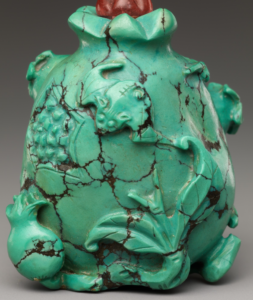
Snuff bottle featuring pomegranates and bat, China, Qing dynasty (1644-1911), Qianlong period (1736-95); turquoise with a pink glass stopper | Image: Metropolitan Museum of Art, New York
In the US the southwest is a significant source for turquoise, Arizona, California, Colorado, New Mexico and Nevada all have areas which were or are particularly rich. Deposits in California and New Mexico were mined by pre-Columbian Native Americans using stone tools – some of which were made locally and others can be traced to central Mexico. The oldest US mines are thought to be in New Mexico, and prior to the 1920s the state was the US’s largest producer of turquoise, although today it is more or less depleted. Only one mine in New Mexico, Apache Canyon, continues to operate on a commercial basis. Fine turquoise can be found in the US but most tends to be of a lower grade – chalk turquoise – with high iron levels which means that greens and yellows predominate and its tendency to have a crumble consistency in an untreated state precludes its use in jewellery.
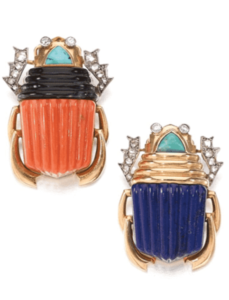
A pair of lapis lazuli, enamel, coral, turquoise and diamond Egyptian revival scarab brooches, Cartier, 1950s | Image: Sotheby’s
China has been a minor source for around 3,000 years or more, with gem quality turquoise found in Hubei province, north west China. Whereas American turquoise is often identified by reference to its mine, Chinese turquoise is invariably known as just this, and colours range widely, from deep green, to dark blues and even yellows with dark blue turquoise with spider webbing the most coveted. Most Chinese turquoise available today has been stabilised, it has filled the gap in the demand for turquoise which the US is no longer able to meet.
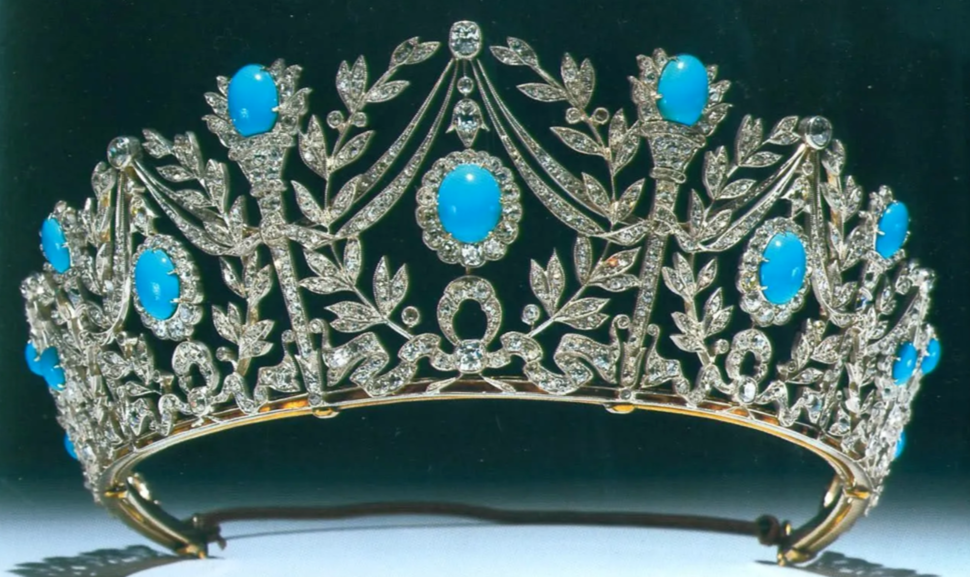
The Triumph of Love tiara, created by Garrard, 1900
As one of the world’s oldest gems turquoise has festooned the rulers of ancient Egypt, the Aztecs, Persia, Mesopotamia, the Indus Valley and China. Many civilisations shared the belief that turquoise possessed certain prophylactic qualities – that it was capable of changing colour with the wearer’s health and so could protect from problematic forces. As used in ancient Egypt, perhaps the best-known items featuring turquoise are those recovered from the tomb of Tutankhamun, the Pharaoh’s burial mask is lavishly inlaid with turquoise, and it is found in the rings and the generous necklaces which decorated the chest, known as pectorals. Turquoise was set in gold, fashioned into beads, used as inlay and carved in scarab motifs, accompanied by carnelian and lapis lazuli. Fast forward to the mid-19th century and Egypt was the focus for archaeological activities which for several decades hooked the world’s imagination, influencing architecture, fine art and the decorative arts – particularly jewellery. Into the early 20th century and Egyptomania continued, fuelled by the excavations in the Valley of the Kings in 1922. Over a period of ten years from the discovery of Tutankhamun’s tomb, The Illustrated London News covered the exciting events in great detail, through frequent articles, interviews, illustrations and colour photographs; an understanding of ancient Egyptian history and archaeology was nurtured and became deeply embedded in the public consciousness. In the edition dated February 26, 1927, Jewels from Tutankhamun’s Mummy: Rings and Bracelets featured many of the items of ‘exquisite craftsmanship’ found buried with the Pharaoh, some of which he was wearing, whereas others were placed on or close to his body. The materials used, including turquoise, were identified along with insights into the design of the jewels revealed through detailed black and white photographs – it reminds one of the highly influential furniture maker’s style guides and directories of the 18th century. Jewels created by Maisons such as Cartier, Van Cleef & Arpels and Boucheron in the first decades of the 20th century were clearly inspired by those worn in ancient Egypt.
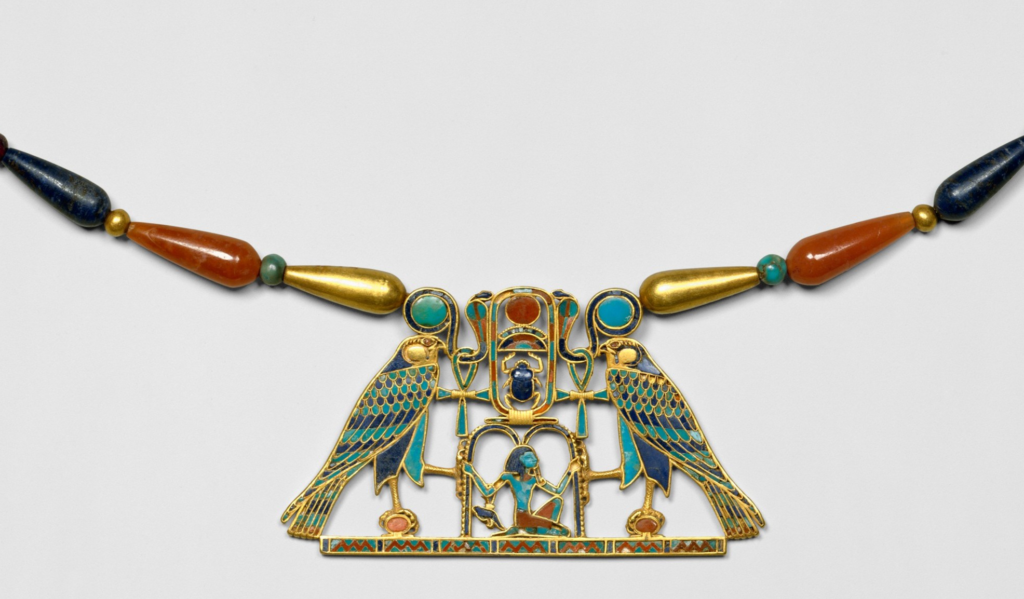
Pectoral and necklace of Sithathoryunet with the name of Senwosret II, gold, carnelian, lapis lazuli, turquoise, garnet (pectoral), gold, carnelian, lapis lazuli, turquoise, green feldspar (necklace), Middle Kingdom period, Dynasty 12, reign of Senwosret II, circa 1887–1878 BCE, Egypt, Fayum Entrance Area, Lahun, Tomb of Sithathoryunet, 1914 excavations | Image: Metropolitan Museum of Art, New York
There is only one turquoise tiara in the royal collection, (to date) – known as the ‘Triumph of Love’ it is set with the finest Persian turquoise. The tiara, along with matching earrings, brooch and necklace, was created in 1900 by Garrard, and in 1923 the suite was given to the late Queen Mother by her soon to be father-in-law, King George V, as a wedding gift. It might not have been the Queen Mother’s favourite parure as she in turn gave it to her daughter, Princess Margaret, on the occasion of her 21st birthday, and the Princess was seen wearing the jewels on many occasions. Although for some years she was second in line to the throne, at the time of her 21st birthday her sister, Princess Elizabeth, was married and had already given birth to her first child, her heir Charles. Margaret’s (increasingly) reduced role perhaps allowed her to strike a modern, more relaxed note, and turquoise certainly partnered very well with this attitude.
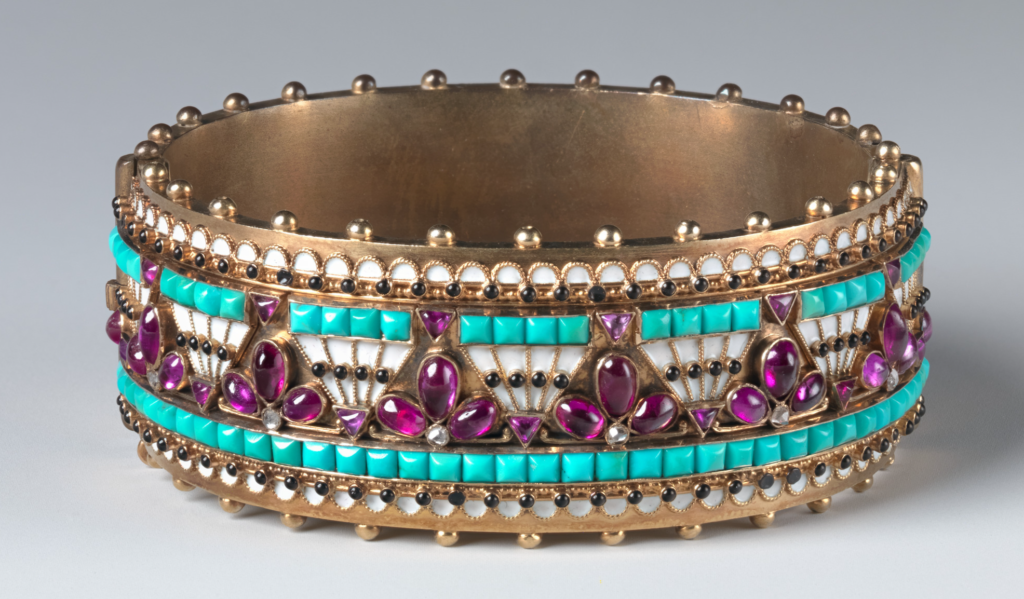
Bracelet from an Egyptian Revival demi-parure, Carlo Giuliano (Italian, active England, circa 1831–1895), retailed by C. F. Hancock, circa 1865. Gold, turquoise, ruby, rose-cut diamond, enamel, seed pearl | Image: Metropolitan Museum of Art, New York
The accessible, breezy quality of turquoise belies its historically revered and treasured status. It is a unique gemstone, capable of playing the starring role in very grand, important jewels but equally well placed to act as a counterpoint and to provide breathing space within elaborate multi-gem settings.

